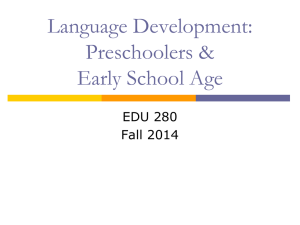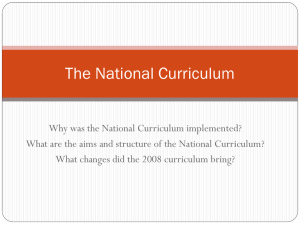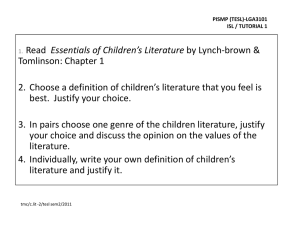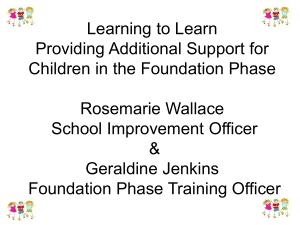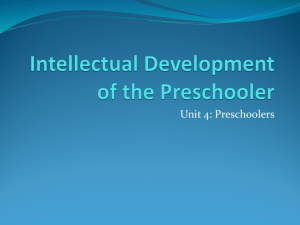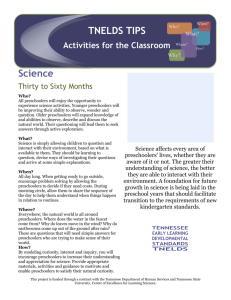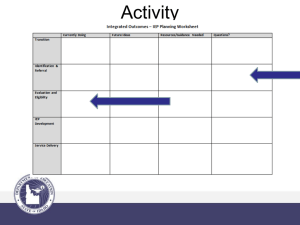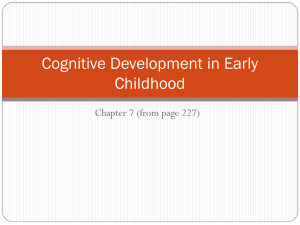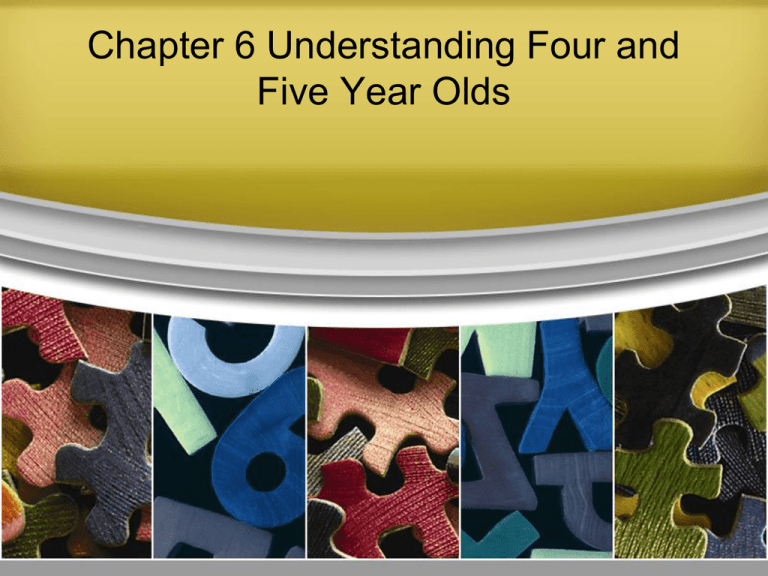
Chapter 6 Understanding Four and
Five Year Olds
Physical Development
• Increased body strength and coordination makes
movement fun
• Body proportions are changing. By 5 ½ years old,
most children’s legs are about half the length of
the body. This makes running, jumping, and
balancing easier for preschoolers.
• Bones become harder and stronger
• Lose baby teeth, gain permanent teeth (good
nutrition is important)
Gross Motor Development
•
•
•
•
They improve their skills as their body becomes stronger and
longer.
At 4 years old:
– one can hop on one foot
– walk down stairs with alternating feet
– can balance on 1 foot for about 10 seconds.
– Can walk backwards, toe to heel for 4 steps.
At 5 years old:
– Begin to skip
– Ride a bike with training wheels
– Can walk forward and backward on a balance beam.
– They can climb fences
– march to music
– Catching and throwing improves.
As the child’s brain matures, there is better coordination of motor
and visual systems.
Fine Motor Development
• String beads
• Work with small games or puzzles (by 5 yrs they can
put together18-35 pieces)
• Build straight and tall towers from blocks
• Writing and drawing skills improve quickly.
• Drawing skills are more refined and adults can
recognize what they’re drawing.
• Begins to recognize letters. They can distinguish
between writing and non-writing
• They can copy and print a few letters, but not often
correctly. Mirror images are difficult.
• Fairly skilled with a writing tool. They can stay in the
lines fairly well.
• They begin to understand letters and sounds are
linked.
Activity: Physical Skills Learning
Centers
Discussion & brainstorm:
• Discuss and brainstorm activities for encouraging
preschoolers to practice printing their names.
How much emphasis should you place on this skill
sand accuracy at this age?
Self Help Skills
•
•
•
•
•
•
•
•
•
•
Dressing and undressing with little help
Can tell front from the back of clothing
Can buckle belts and close zippers
By 5, may even button and unbutton
Can put shoes on the right feet; may tie own
shoelaces
Self feeding is easier. They enjoy helping with
serving. They can use spoons/forks with ease
Can cut some foods with knife.
Better able to take care of hygiene
Can brush own teeth
Can comb their hair
Discuss:
• What kinds of activities or toys would encourage
self help skills?
Cognitive Development
• This is a time for huge gains.
• Preschoolers have become more skilled in
thinking without having to act things out, so they
have a better understanding of symbols than
younger children.
• They have increased language comprehension
and expressive language.
• You can test a preschooler’s recognition and
recall skills.
Play the memory game.
• Top recall the items requires the child to create a
mental image. Although the child can recognize
all 10 items, he/she can probably only recall 4 or
5. They have better recognition skills than recall
skills.
Play changes
• Children start creating their own symbols at this age,
and this is reflected in their play. Instead of imitating
adults, they begin to add their own ideas. New
symbols begin in art. Before 4 years old, children tend
to scribble or just draw simple shapes
• Understanding symbols is important for developing
more advanced cognitive skills. Cognitive
development during the preschool years helps prepare
children for future learning during the school years.
2 year old
3 year old
4 year old
5 year old
Preschoolers are curious
• They want to learn why things happened around
them. They ask a lot of questions and are trying
to make sense of the world. They still have flaws
in their thinking, but asking questions again and
again makes their thinking become more and
more logical.
• Your curriculum should promote children’s
cognitive growth. As you provide new
experiences, the children’s vocabularies will grow.
They will learn new concepts.
What kinds of skills does having a
class pet teach?
• Size, color, method of eating, new vocabulary
words. Each new experience helps the children
grow intellectually.
• Role Playing Activity: A teacher is comforting a
child who is very sad at the loss of a beloved pet.
Evaluate the teacher’s effectiveness in meeting
the child’s need.
Language Comprehension Skills
• The language comprehension skills of 4 and 5
year olds are growing constantly. New words
related to space increase their understanding
(beside, above, below, backward, bottom,
forward) they also understand down, low, different
and thin. As you instruct these students, children
will be able to understand and follow directions.
“Place the green block behind the blue block”
• They become better at following 3 step
commands. “ Pick up the puzzle, put it on the
table, and wash your hands” However, if you don’t
sequence the directions correctly, it may confuse
the child.
Language Comprehension skills
cont.
• Children have a better understanding of singular
and plural. Sandwich vs. cookies
• Children start understanding the passive voice
sentence. “the orange was eaten by Brock.” A
younger child would think that the orange ate
Brock. The 4-5 year old would understand that
Brock ate the orange.
• Words and phrases have more than 1 meaning,
preschoolers can become confused by this.
“Wanda just flew out the door.” or “I’m dying of
hunger”
Reading
• Most 4-5 year olds cannot read, but are
developing pre-reading skills. This starts by
understanding symbolism. Children first need to
understand that a group of letters on paper can
symbolize any object.
• Preschoolers can recognize and name many
letters of the alphabet as well as their own names.
• They enjoy reading the same stores over and
over and may be able to pick out words they
recognize.
• They can guess words they dont recognize by
looking at the first letter and the pictures for clues.
Expressive Language skills
• Children at this age tend to talk to you rather than
converse with you. When you talk about a
subject, they may interrupt you to talk about
something entirely unrelated. In later years they
will be better at 2-way communication.
Articulation
• The ability to produce sounds of language. This
improves greatly at ages 4-5. Most children still
have trouble making the ch sound and the th
sound. Others may have trouble with the S
sound, causing a lisp.
• Some preschoolers have stuttering problems.
Stuttering is the repeated sound or words and
pausing for unusually long times while speaking.
For most preschoolers, stuttering is a result of
thinking faster than they can talk. As children’s
speech ability catches up to their thinking ability,
the stuttering problem tends to disappear.
Vocabulary
• Most 4 year olds have about 1500 words in their
vocabularies.
• 5 year olds: 2000.
• Children at this age may make up their own
meanings to some words.
• They have mainly concrete nouns and action
verbs in their vocabularies. They are beginning to
add modifiers and adjectives to their vocabularies,
so children would be unlikely to use the words
freedom or unfair unless they were copying the
words of adults.
Imitation
• They do imitate phrases they hear from adults of
TV. Often they don’t know what these words
mean, only that they’ve heard them before.
Grammar
• Grammar improves during preschool years.
Children start to learn there are exceptions to
grammar rules. (ate, ran, and went)
• They still put -ed at the end of words occasionally.
• They learn how to properly ask questions.
– 3 year old might ask “why the sky is blue?”
– 4 or 5 year old might ask “Why is the sky blue?”
• Some forms of pronouns give preschoolers trouble
still. “Him and me are going to the zoo.”
• They also have trouble with noun and verb
agreement “Tommy don’t have a crayon”
Math Skills
• Number concepts become easier for children of
this age.
• Rote counting is gained by most children before
they understand that each number represents a
certain amount.
• Most 4 year olds can rote count to 9
• Most 5 year olds can rote count to 20
• Rote counting develops at different rates,
therefore you need to observe children to make
sure your curriculum fits their skill levels.
Math Skills cont.
• True counting, in which an object is counted for
each number named, develops more slowly.
Math concepts cont.
• At 4 years old, they usually recognize numerals 1-5
• 5 year olds usually recognize 1-10. They can
even dial their own phone numbers.
• Other math skills develop at this age. They’re
better able to recognize shapes and can
understand terms related to size and number
such as short, fat, tallest, same, first and last.
• They begin to understand money concepts. Most
can identify a penny, nickel and dime. They don’t
understand the value of the money though.
• Time concepts are more clear but are still
confusing. They start to understand the
difference between today, tomorrow and
yesterday but they don’t understand how much
time an hour or 5 minutes is.
Reading and Math Fun Activity
Social-Emotional Development
• Preschoolers are helpful, cheerful and
cooperative. Emotions are changing in children at
this age. As they learn and grow, the causes of
happiness, fear, anger, and sadness change.
The ways children react to these emotions
change too.
Social Development
• Companionships and friendships are important at
this age. Preschoolers are becoming more
independent of adults. They like to play on their
own or with other children. They may still need
adults though to settle disputes or to help get
materials.
• They tend to have a few friends, usually of the
same sex. They are more likely to share their toys
with a friend.
• Over 1/3 of a four year old child’s play is solitary
play. By age 5, play involves more interaction
and cooperation.
• Children of this age accept supervision. They
know their own abilities and realize adults have
reasons for rules.
Emotional Development
• They start to realize that there are other ways of
showing love other than a hug or physical signs of
affection. They start to realize that sharing or
helping with a task is a way of showing you care.
• Children may ask for help with a task even if they
don’t need it just to assure them that you care.
• Children start to develop a sense of humor.
Laughter is a way of expressing their happiness.
They also laugh at things they know are unusual ,
like a dog that says “meow” in a story.
Fear
• Causes of fear change at this age. Children are
still afraid of imagined creatures, such as
monsters and ghosts. They start to understand
there is a difference between the real and the
imagined. This helps children deal with some of
these fears.
• Other fears can be created with new knowledge.
They are aware of new dangers.
• 5 year olds are more afraid of being hurt. They
know of more things that can hurt them. They may
be afraid of doctors and dentists or of high places
and dogs because of prior experiences.
• Children work through fears in play. It helps them
act out some of their intense feelings and deal
with their fears.
Discuss:
• Parents and caregivers may unintentionally
increase children’s fears when teaching about
strangers. How can you teach children about
strangers without adding to their fears?
Anger
• Less things anger preschoolers than toddlers.
• However, they can get angry if they cannot reach
their goals.
• They are more likely to use their words and yelling
rather than kicking and screaming.
• Some preschoolers respond more physically to
anger than other preschoolers by hitting, kicking,
pushing, etc. They may not have learned better
ways of expressing anger from adult role models
or they may want attention.
Jealousy
• Jealousy may surface in many ways: regression,
physical problems such as stomachaches or
nightmares.
• These children need to be reassured that they are
still loved and given a little extra attention to make
them feel special.
Sadness
• 4-5 year olds become aware of situations of
sadness, like death.
• Children are not always sure how to express
sadness. They may deal with sadness in play.
Often they need help from adults to learn that it is
okay to cry and talk about their feelings. They
need adults to model appropriate responses to
sadness and to provide clear explanations.
Teaching 4 and 5 year olds
• Children of this age enjoy feeling needed and
important and like to be helpful. You need to
carefully select helpers so that all get a chance to
help even from those not as vocal.
• Children at this age love talking. After you read a
story, the children may enjoy retelling a story.
• They are usually able to retell it in sequence and
in detail.
• Children of this age will imitate your speech. For
this reason you need to be careful of your
statements. You should not use words or
statements you wouldn’t want them repeating.
Teaching 4 and 5 year olds cont.
• You do not need to function as a playmate as
much now, but you will handle more disputes
among children.
• You will want to add new ideas to play also.
• Some children will have imaginary friends to
which you can encourage and tend to.
Teaching 4 and 5 year olds cont.
• Children are proud of their possessions and may
enjoy bringing toys to preschool, or will be proud
of new shoes or a jacket. Asking children
questions about their things can help build their
self esteem.
• Their attention span is increasing and they enjoy
working on projects such as woodworking,
cooking, sculpting clay, etc. As they get older they
will engage for longer periods of time. The
average time spent in most activities at this age is
about 7 minutes.
Teaching 4 and 5 year olds cont.
• Discussion: What safety and sanitation guidelines
need to be followed for woodworking and cooking
projects in preschool? Discus your opinions on
the value of these activities in the preschool
curriculum.

